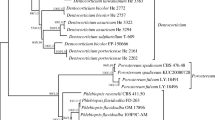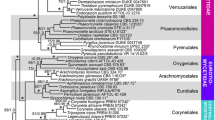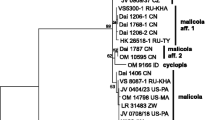Abstract
An epigeous fungus forming sequestrate basidiomata with reduced lamellae is described as new to science. A phylogeny based on ITS, LSU, and ef-1α markers demonstrate that P. secotioides nests with strong support in the Psathyrellaceae, more precisely in the Psathyrella candolleana clade, representing the first secotioid form known in the Psathyrellaceae. Psathyrella secotioides is sister to a clade encompassing P. candolleana, P. badiophylla, P. leucotephra, and P. hymenocephala. Dark brown spores without a germ pore and a hymeniform pileipellis structure are synapomorphic characters shared with the rest of the species of the P. candolleana clade (Psathyrella sect. Spintrigerae). On the contrary, longer spores with thicker walls, and the apparent loss of cheilocystidia are derived characters, probably linked with producing secotioid basidiomata and related to the loss of forcible spore discharge. Estimation of divergence times using a molecular clock suggests that Psathyrella secotioides diverged from the core P. candolleana group around 3.6–5.1 Mya (1.6–9.5), approximately when the climate aridization that originated the Sonoran desert started. Psathyrella secotioides is described macro- and microscopically in detail, and microphotographs under optical microscope and SEM are provided.


Similar content being viewed by others
References
Albee-Scott SR (2007) Does secotioid inertia drive the evolution of false-truffles? Mycol Res 111:1030–1039
Arenal F, Villarreal M, Esteve-Raventós F (2003) Psathyrella albofloccosa, a new species of section Cystopsathyra. Mycotaxon 87:173–177
Binder M, Hibbett DS (2006) Molecular systematics and biological diversification of Boletales. Mycologia 98:971–981
Drummond AJ, Rambaut A (2007) Beast: Bayesian evolutionary analysis by sampling trees. BMC Evol Biol 7:214
Esteve-Raventós F, Villarreal M (2002) Two new species of Psathyrella. Czech Mycol 54:83–91
Geml J (2004) Evolution in action: molecular evidence for recent emergence of secotioid genera Endoptychum, Gyrophragmium and Longula from Agaricus ancestors. Acta Microbiol Immunol Hung 51:97–108
Geml J, Tulloss RE, Laursen GA, Sazanova NA, Taylor DL (2008) Evidence for strong inter- and intracontinental phylogeographic structure in Amanita muscaria, a wind-dispersed ectomycorrhizal basidiomycete. Mol Phylogenet Evol 48:694–701
Hallen HE, Halling R, Adams GC (2003) Taxonomy and toxicity of Conocybe lactea and related species. Mycol Res 107:969–979
Hansen K, Pfister DH, Hibbett DS (1999) Phylogenetic relationships among species of Phillipsia inferred from molecular and morphological data. Mycologia 91:299–314
Hawksworth DL, Kirk PM, Sutton BC, Pegler DN (1995) Ainsworth & Bisby’s dictionary of the fungi, 8th edn. CAB International, Wallingford, 616 p
Heinemann P, Rammeloo J (1985) De la mesure des spores et de son expression. Agarica 6:366–380
Heykoop M (2001) Bases corológicas de Flora Micológica Ibérica. Adiciones y números 1677-1744. In: Pando F, Hernández JC (eds) Cuadernos de Trabajo de Flora Micológica Ibérica 15. Madrid: Consejo Superior de Investigaciones Científicas. Real Jardín Botánico. 15:139–187
Heykoop M, Esteve-Raventós F (1994) El género Psathyrella (Fr.) Quél. en España. I. (Especies recolectadas en Guadalajara). Bol Soc Micológica Madrid 19:37–57
Heykoop M, Moreno G (1998) The genus Psathyrella in Spain. II. Psathyrella longicystiata sp nov. Mycotaxon 69:479–486
Heykoop M, Moreno G (2001) Studies in the genus Psathyrella in Spain. III. Psathyrella magnispora, a new species in subsection lutenses. Z Mykologie 67:55–62
Heykoop M, Moreno G (2002) Studies in the genus Psathyrella in Spain. IV Psathyrella submicrospora sp nov and P microsporoides nom nov. Mycotaxon 83:425–433
Heykoop M, Moreno G, Llarandi E (2004) El género Psathyrella (Fr.) Quél. en España. V. Algunas especies raras o interesantes. Boletín Sociedad Micológica de Madrid 28:271–285
Hibbett DS (2007) After the gold rush, or before the flood? Evolutionary morphology of mushroom-forming fungi (Agaricomycetes) in the early 21st century. Mycol Res 11:1001–1018
Hibbett DS, Pine EM, Langer E, Lange G, Donogue MJ (1997) Evolution of gilled mushrooms and puffballs inferred from ribosomal DNA sequences. Proc Natl Acad Sci U S A 94:2002–12006
Hopple JS, Vilgalys R (1999) Phylogenetic relationships in the mushroom genus Coprinus and dark-spored allies based on sequence data from the nuclear gene coding for the large ribosomal subunit RNA: divergent domains, outgroups, and monophyly. Mol Phylogenet Evol 13:1–19
Hosaka K, Bates ST, Beevewr RE, Castellano MA, Colgan W, Dominguez LS, Nouhra ER, Geml J, Giachini AJ, Kenney SR, Simpson NB, Trappe JM (2006) Molecular phylogenetics of the gomphoid-phalloid fungi with an establishment of the new subclass Phallomycetidae and two new orders. Mycologia 98:949–959
Justo A, Morgenstern I, Hallen-Adams HE, Hibbett DS (2010) Convergent evolution of sequestrate forms in Amanita under Mediterranean climate conditions. Mycologia 102:675–688
Kirk PM, Cannon PF, Minter DW, Stalpers JA (2008) Ainsworth & Bisby’s dictionary of the fungi, 10th edn. CABI, Europe-UK, 771 p
Kits van Waveren E (1985) The Dutch, French and British species of Psathyrella. Persoonia Suppl 2:1–300
Larsson E, Örstadius L (2008) Fourteen coprophilous species of Psathyrella identified in the Nordic countries using morphology and nuclear rDNA sequence data. Mycol Res 112:1165–1185
Miller MA, Pfeiffer W, Schwartz T (2010) Creating the CIPRES Science Gateway for inference of large phylogenetic trees. In: Proceedings of the Gateway Computing Environments Workshop (CGE), 14 Nov 2010, New Orleans, Louisiana. p 1–8
Moncalvo JM, Buchanan PK (2008) Molecular evidence for long distance dispersal across the Southern Hemisphere in the Ganoderma applanatum-australe species complex (Basidiomycota). Mycol Res 112:425–436
Moreno G, Castillo A (2013) A comparative study of the types of three species of Myxomycetes: Trichia crateriformis, T fallax var olivacea and T fernbankensis. Bol Soc Micológica Madrid 37:85–98
Moreno G, Illana C, Heykoop M (1987) Gastrocybe iberica sp. nov. in Spain (Bolbitiaceae, Agaricales). Cryptogam Mycol 8:321–327
Nagy LG, Kocsubé S, Papp T, Vágvölgyi C (2009) Phylogeny and character evolution of the coprinoid mushroom genus Parasola as inferred from LSU and ITS nrDNA sequence data. Persoonia 22:28–37
Nagy LG, Urban A, Orstadius L, Papp T, Larsson E, Vágvölgyi C (2010) The evolution of autodigestion in the mushroom family Psathyrellaceae (Agaricales) inferred from Maximum Likelihood and Bayesian methods. Mol Phylogenet Evol 57:1037–1048
Nagy LG, Walther G, Házi J, Vágvölgyi C, Papp T (2011) Understanding the evolutionary processes of fungal fruiting bodies: correlated evolution and divergence times in the Psathyrellaceae. Syst Biol 60:303–317
Nagy LG, Házi J, Szappanos B, Kocsubé S, Bálint B, Rákhely G, Vágvölgyi C, Papp T (2012) The evolution of defense mechanisms correlate with the explosive diversification of autodigesting Coprinellus mushrooms (Agaricales, Fungi). Syst Biol 61:595–607
Nagy LG, Vágvölgyi C, Papp T (2013) Morphological characterization of clades of the Psathyrellaceae (Agaricales) inferred from a multigene phylogeny. Mycol Prog 12:505–517
Neville P, Poumarat S, Ivaldi P (2004) Récoltes provençales de Descolea tenuipes (Setch.) Neville et Poumarat com. nov. Étude sur la variabilité sporique. Bull Soc Mycol France 120:51–71
Padamsee M, Matheny PB, Dentinger BTM, McLaughlin DJ (2008) The mushroom family Psathyrellaceae: Evidence for large-scale polyphyly of the genus Psathyrella. Mol Phylogenet Evol 46:415–429
Peintner U, Bougher NL, Castellano MA, Moncalvo JM, Moser MM, Trappe JM, Vilgalys R (2001) Multiple origins of sequestrate fungi related to Cortinarius (Cortinariaceae). Am J Bot 88:2168–2179
Rambaut A (2009) FigTree 1.2.2. Distributed by the author. http://tree.bio.ed.ac.uk/software/figtree/
Rambaut A, Drummond AJ (2007) Tracer v1.5. Computer program and documentation distributed by the authors at http://beast.bio.ed.ac.uk/Tracer
Redhead SA, Vilgalys R, Moncalvo JM, Johnson J, Hopple JS (2001) Coprinus Persoon and the disposition of Coprinus species sensu lato. Taxon 50:203–241
Rehner S, Buckley E (2005) A Beauveria phylogeny inferred from nuclear ITS and EF1-α sequences: evidence for cryptic diversification and links to Cordyceps teleomorphs. Mycologia 97:84–98
Ronquist F, Teslenko M, Van der Mark P, Ayres D, Darling A, Höhna S, Larget B, Liu L, Suchard MA, Huelsenbeck JP (2012) MrBayes 3.2: Efficient Bayesian phylogenetic inference and model choice across a large model space. Syst Biol 61:539–542
Smith AH (1972) The North American species of Psathyrella. Mem N Y Bot Gard 24:1–633
Stamatakis A (2006) Raxml-VI-HPC: maximum likelihood-based phylogenetic analyses with thousands of taxa and mixed models. Bioinformatics 22:2688–2690
Suchard MA, Huelsenbeck JP (2011) MrBayes 3.2: Efficient Bayesian phylogenetic inference and model choice across a largemodel space. Syst Biol 61:539–542
Swofford DL (2002) PAUP* phylogenetic analysis using parsimony (*and Other methods). Version 4. Sinauer Associates, Sunderland
Thiers HD (1984) The secotioid syndrome. Mycologia 76:1–8
Van Devender TR (2000) The deep history of the Sonoran Desert. In: Phillips SJ, Comus PW (eds) A natural history of the Sonoran Desert. Arizona-Sonora Desert Museum Press/University of California Press, Tucson, pp 61–69
Vasutová M, Antonin V, Urban A (2008) Phylogentic studies in Psathyrella focusing on sections Pennatae and Spadiceae - New evidence for the paraphyly of the genus. Mycol Res 112:1153–1164
Vidal M, Calonge FD, Martin MP (2002) Macowanites ammophilus (Russulales) a new combination based on new evidence. Rev Catalana Micol 24:69–74
Vilgalys R, Hester M (1990) Rapid genetic identification and mapping of enzymatically amplified ribosomal DNA from several Cryptococcus species. J Bacteriol 172:4238–4246
White TJ, Bruns T, Lee S, Taylor J (1990) Amplification and direct sequencing of fungal ribosomal RNA genes for phylogenetics. In: Inns MA, Gelfand DH, Sninsky JJ, White TJ (eds) PCR protocols: a guide to methods and applications. Academic, San Diego, pp 315–322
Acknowledgments
We wish to express our gratitude to Dr. L. Monje and Mr. A. Pueblas of the Department of Drawing and Scientific Photography at the University of Alcalá for his help in the digital preparation of the photographs, to Dr. J. Rejos, curator of the AH herbarium for his assistance with the specimens examined in the present study. We thank Maria Prieto for advise in the molecular dating analyses.
Author information
Authors and Affiliations
Corresponding author
Electronic supplementary material
Below is the link to the electronic supplementary material.
Supplementary Table I
(DOCX 21 kb)
Rights and permissions
About this article
Cite this article
Moreno, G., Heykoop, M., Esqueda, M. et al. Another lineage of secotioid fungi is discovered: Psathyrella secotioides sp. nov. from Mexico. Mycol Progress 14, 34 (2015). https://doi.org/10.1007/s11557-015-1057-8
Received:
Revised:
Accepted:
Published:
DOI: https://doi.org/10.1007/s11557-015-1057-8




